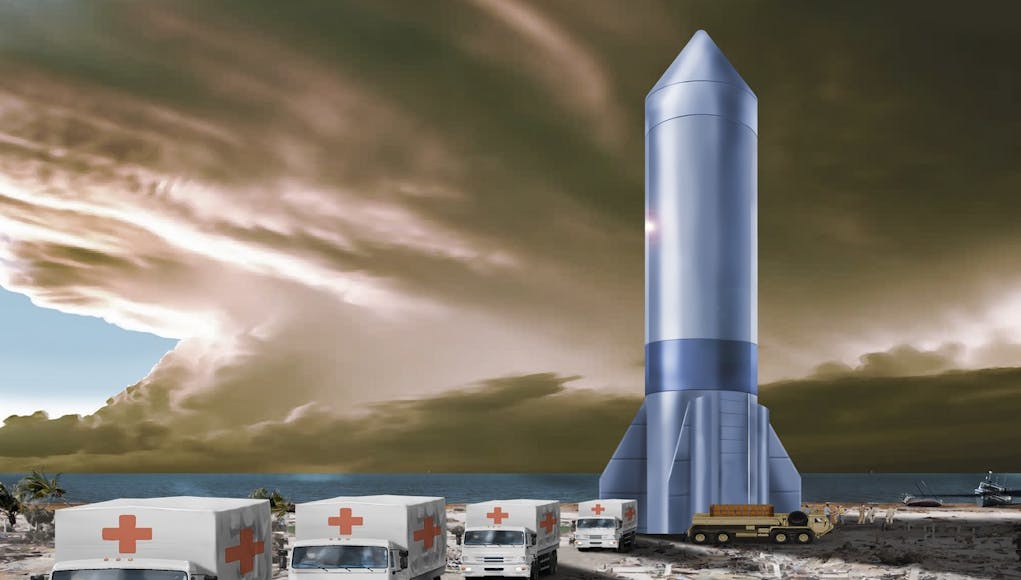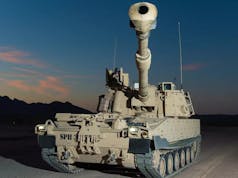The U.S. Air Force have announced the designation of ‘Rocket Cargo’ as the fourth Vanguard programme as part of its transformational science and technology portfolio identified in the DAF 2030 Science and Technology strategy for the next decade.
Additionally, the U.S. Space Force was designated as the lead service for Rocket Cargo Vanguard, marking the service’s first such program.
“Under the Rocket Cargo Vanguard, the Air Force Research Laboratory will lead a science and technology effort to determine the viability and utility of using large commercial rockets for Department of Defense global logistics, potentially expanding the portfolio of capabilities the USSF presents to combatant commanders. The Space and Missile Systems Center will serve as the Program Executive Officer.
AFRL will research and develop the unique aspects needed to leverage the new commercial capability for the DoD logistics mission. This includes the ability to land a rocket on a wide range of non-traditional materials and surfaces, including at remote sites. In addition, AFRL scientists and engineers will research the ability to safely land a rocket near personnel and structures, engineer a rocket cargo bay and logistics for rapid loading and unloading, and air drop cargo from the rocket after re-entry in order to service locations where a rocket or aircraft cannot possibly land.”
“The Air Force has provided rapid global mobility for decades and Rocket Cargo is a new way the Department can explore complementary capabilities for the future,” said Acting Secretary of the Air Force John Roth.
“Vanguard initiatives lead to game-changing breakthroughs that preserve our advantage over near-peer competitors, and this latest addition is also a significant milestone as the first Vanguard evaluated under the Space Force’s oversight.”
Based on the advertised commercial capability and business objectives, the AFRL is currently assessing emerging rocket capability across the commercial vendor base, and its potential use for quickly transporting DoD materiel to ports across the globe.
“The Rocket Cargo Vanguard is a clear example of how the Space Force is developing innovative solutions as a service, in particular the ability to provide independent options in, from, and to space,” said Chief of Space Operations Gen. John W. “Jay” Raymond.
“Once realized, Rocket Cargo will fundamentally alter the rapid logistics landscape, connecting materiel to joint warfighters in a fraction of the time it takes today. In the event of conflict or humanitarian crisis, the Space Force will be able to provide our national leadership with an independent option to achieve strategic objectives from space.”
Delivering cargo via rocket transportation is not a new concept.
Historically the high costs of launch have been prohibitive for a logistics-focused application, and the relatively small payload capability constrained the types of cargo that could be delivered, also limiting its suitability.
Today several commercial companies are quickly generating new opportunities by developing large rockets and reusable stages that safely land back on earth, expanding cargo capacity and dramatically reducing launch costs.













seriously ? 😱
Yep Space X Super Heavy does generate this type of opportunity.
Yes. “AFRL will research and develop the unique aspects needed to leverage the new commercial capability” and looking at the specification for what the US military wants from that “commercial capability”, in particular it specifies a 100 ton payload, makes it pretty clear that SpaceX Starship is going to be the commercial capability that they will be working with. 100 tons just happens to be the initial target payload to LEO for Starship and as far as I’m aware nothing else currently under development has that sort of payload capability except for NASA’s SLS and that has zero reusability and no way to deliver that payload back to Earth which makes it totally useless for this project.
I see another big fat contract coming SpaceX’s way sometime this year. All good if it helps get Starship developed more quickly. If SpaceX can manage the first sub-orbital flight with the full 2 stage stack sometime this year that will be a huge milestone but it’s going to be a challenge. Even Musk admits that multiple attempts are likely before they succeed in getting a prototype into orbit and, crucially, getting it back to Earth safely afterwards. They do seem to be making good steady progress on the development plan though.
Can Starship land with 100 tons of cargo?
Not sure but its design goal is 100 tons to LEO initially with a plan to grow that to 150 tons as the thrust/weight ratio on the engines improves over various design iterations (apparently the Merlin engines in Falcon 9 now have about twice the TWR vs the fist prototypes thanks to design improvements). While that doesn’t answer your question remember that those figures are for actually getting into LEO whereas global surface to surface flights could, with maybe a very few exceptions, be sub-orbital and fuel not needed to get a payload fully into orbit would then presumably be available to allow a longer landing burn to account for payload mass still being on board at landing.
Musk has sub-orbital passenger flights on his plan for Starship (although personally I struggle to see that becoming realistic for the general public any time soon) so his basic Starship design certainly allows for landing more than an empty rocket back on Earth after a flight but say 100 to 200 passengers is certainly far less than 100 tons unless they are a bunch of VERY fat people.
Hi Julian, thanks for the interesting reply. I hadn’t really considered the sub orbital flight aspect.
Its a facinating proposition, but I do wonder just where the need is and how the cost/benefit analysis works out vs developing a new heavy lift strategic transport.. . How often does the US find itself needing to move kit at that short notice.
Cheers
Chris.
Not to mention Emissions I guess….. 😯
The emissions part is mainly generating the Hydrogen and Oxygen for fuel.
Oh, I’m no Rocket Scientist…… is it clean then ?
Methane and O2 for the oxidiser which I believe results in Water and CO2
The Falcon Super Heavy delivers to orbit.
They’re looking at using Starship as SpaceX has already touted its use for passenger and cargo transport around the globe.
But……realistically how much would this cost and how would you get the rocket back.
Spacex, then. Starship generates a lot of heat during slowdown. Nice target for anti ballistic missile defence system?
My thought exactly any tribespeople with a shoulder launched heat seeking missile could knock 1 out the sky on its landing trajectory and then let it rain down 100 tons of burning cargo on to the landing site.
Best option likely an ocean hopper that lands nowhere near the battle front. For the reason stated and also to avoid confusion over what’s aproaching the enemy lines!
Calling International Rescue – launch Thunderbird 1
Looks more like something from a Flash Gordon movie.
Yes. ‘Starship’ – why that name? it’s concept is interplanetary. Pretty good, but it’s not going anywhere near the stars!
I’m hoping that Musk has a vehicle design that looks a lot less Flash (no relation, by the way). That the current iteration is just a cheap skin for the advanced technology, in other words.
if they don’t call it Thunderbird I will be very dissapointed.
Amazon Prime?
Wrong date.
😂 …….
This seems like a somewhat crazy way of burning millions of dollars for what would seem to be a very niche operational need. How many of these things would they need?
How often does the US military need to transport 100+ tons of cargo at very short notice?
Wouldn’t the money be better spent on new build C5’s or similar large transport aircraft?
I don’t know the answer, I’m not a rocket scientist!